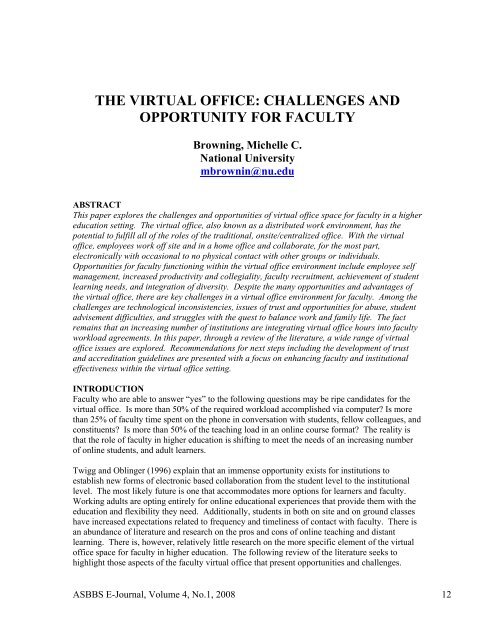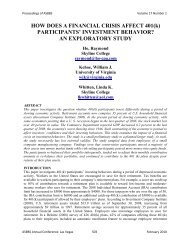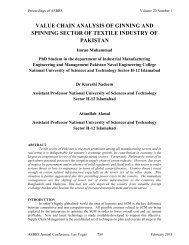stock repurchase announcements: a test of market ... - Asbbs.org
stock repurchase announcements: a test of market ... - Asbbs.org
stock repurchase announcements: a test of market ... - Asbbs.org
Create successful ePaper yourself
Turn your PDF publications into a flip-book with our unique Google optimized e-Paper software.
THE VIRTUAL OFFICE: CHALLENGES AND<br />
OPPORTUNITY FOR FACULTY<br />
Browning, Michelle C.<br />
National University<br />
mbrownin@nu.edu<br />
ABSTRACT<br />
This paper explores the challenges and opportunities <strong>of</strong> virtual <strong>of</strong>fice space for faculty in a higher<br />
education setting. The virtual <strong>of</strong>fice, also known as a distributed work environment, has the<br />
potential to fulfill all <strong>of</strong> the roles <strong>of</strong> the traditional, onsite/centralized <strong>of</strong>fice. With the virtual<br />
<strong>of</strong>fice, employees work <strong>of</strong>f site and in a home <strong>of</strong>fice and collaborate, for the most part,<br />
electronically with occasional to no physical contact with other groups or individuals.<br />
Opportunities for faculty functioning within the virtual <strong>of</strong>fice environment include employee self<br />
management, increased productivity and collegiality, faculty recruitment, achievement <strong>of</strong> student<br />
learning needs, and integration <strong>of</strong> diversity. Despite the many opportunities and advantages <strong>of</strong><br />
the virtual <strong>of</strong>fice, there are key challenges in a virtual <strong>of</strong>fice environment for faculty. Among the<br />
challenges are technological inconsistencies, issues <strong>of</strong> trust and opportunities for abuse, student<br />
advisement difficulties, and struggles with the quest to balance work and family life. The fact<br />
remains that an increasing number <strong>of</strong> institutions are integrating virtual <strong>of</strong>fice hours into faculty<br />
workload agreements. In this paper, through a review <strong>of</strong> the literature, a wide range <strong>of</strong> virtual<br />
<strong>of</strong>fice issues are explored. Recommendations for next steps including the development <strong>of</strong> trust<br />
and accreditation guidelines are presented with a focus on enhancing faculty and institutional<br />
effectiveness within the virtual <strong>of</strong>fice setting.<br />
INTRODUCTION<br />
Faculty who are able to answer “yes” to the following questions may be ripe candidates for the<br />
virtual <strong>of</strong>fice. Is more than 50% <strong>of</strong> the required workload accomplished via computer? Is more<br />
than 25% <strong>of</strong> faculty time spent on the phone in conversation with students, fellow colleagues, and<br />
constituents? Is more than 50% <strong>of</strong> the teaching load in an online course format? The reality is<br />
that the role <strong>of</strong> faculty in higher education is shifting to meet the needs <strong>of</strong> an increasing number<br />
<strong>of</strong> online students, and adult learners.<br />
Twigg and Oblinger (1996) explain that an immense opportunity exists for institutions to<br />
establish new forms <strong>of</strong> electronic based collaboration from the student level to the institutional<br />
level. The most likely future is one that accommodates more options for learners and faculty.<br />
Working adults are opting entirely for online educational experiences that provide them with the<br />
education and flexibility they need. Additionally, students in both on site and on ground classes<br />
have increased expectations related to frequency and timeliness <strong>of</strong> contact with faculty. There is<br />
an abundance <strong>of</strong> literature and research on the pros and cons <strong>of</strong> online teaching and distant<br />
learning. There is, however, relatively little research on the more specific element <strong>of</strong> the virtual<br />
<strong>of</strong>fice space for faculty in higher education. The following review <strong>of</strong> the literature seeks to<br />
highlight those aspects <strong>of</strong> the faculty virtual <strong>of</strong>fice that present opportunities and challenges.<br />
ASBBS E-Journal, Volume 4, No.1, 2008 12

















